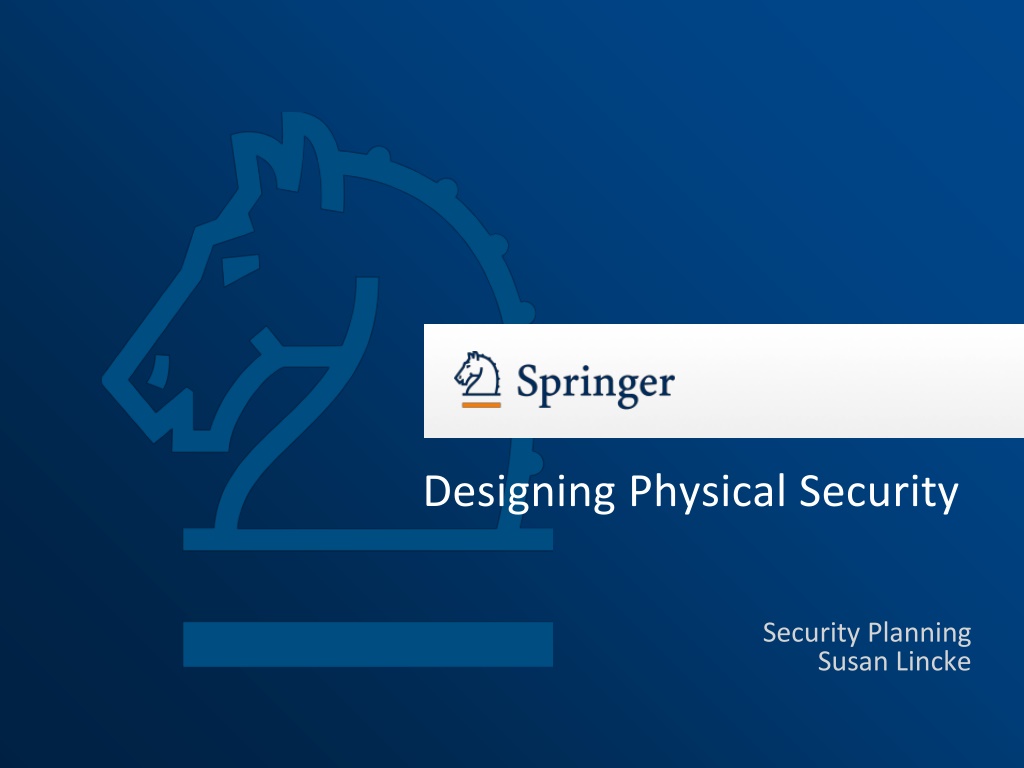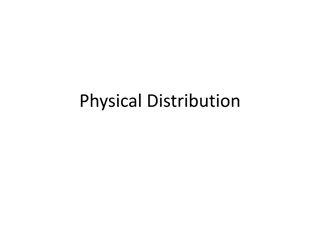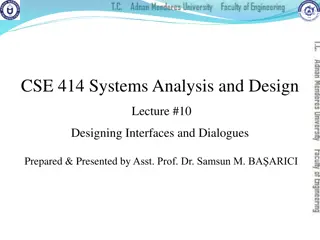Comprehensive Guide to Designing Physical Security and Security Planning by Susan Lincke
This comprehensive guide provides valuable insights into designing physical security and security planning, covering topics such as power failures, protections, fire suppression systems, physical access controls, asset security, sensitivity and criticality classification, and more. It offers practical approaches and solutions to address various security challenges in both IT and non-IT assets.
Download Presentation

Please find below an Image/Link to download the presentation.
The content on the website is provided AS IS for your information and personal use only. It may not be sold, licensed, or shared on other websites without obtaining consent from the author. Download presentation by click this link. If you encounter any issues during the download, it is possible that the publisher has removed the file from their server.
E N D
Presentation Transcript
Designing Physical Security Security Planning Susan Lincke
Security Planning: An Applied Approach | 9/13/2024| 2 Objectives The students should be able to: Define power failures: blackout, brownout, sags, spike & surges, electromagnetic interference (EMI) Define protections against power failures: surge protector, universal power supply (UPS) , alternate power generators Define and describe mediums for Fire Suppression System: dry pipe, charged, FM200, Argonite Define physical access controls: biometric door locks, bolting, deadman doors Describe the relationship between deadman door and piggybacking
Security Planning: An Applied Approach | 9/13/2024| 3 Physical Security Problems Assets: Computer: computer devices, equipment, files/media Non-IT: equipment, paper files or other things of value: money, checks, art, chemicals, prototypes, ideas on boards, etc. Attacks: Skimmer-attacks: ATM, Point of Sale at banks, gas stations, retail stores Organization-reported: lost, misdelivered or stolen media, documents, and faxes. Vandalism
Security Planning: An Applied Approach | 9/13/2024| 4 Steps in Designing Physical Security Inventory Assets & Assign Classes Select Controls for Sensitivity Classes Select Controls for Criticality Classes
Security Planning: An Applied Approach | 9/13/2024| 5 Remember Sensitivity Classification Proprietary: Strategic Plan Confidential: Salary & Health Info Privileged: Product Plans Internal Public Product Users Manual near Release
Security Planning: An Applied Approach | 9/13/2024 | 6 and Criticality Classification? Critical $$$$: Cannot be performed manually. Tolerance to interruption is very low Vital $$: Can be performed manually for very short time Sensitive $: Can be performed manually for a period of time, but may cost more in staff Nonsensitive : Can be performed manually for an extended period of time with little additional cost and minimal recovery effort
Security Planning: An Applied Approach | 9/13/2024 | 7 Step 1: Inventory & Classify Room Room Purpose of Room Sensitivity & Criticality Class Privileged, Vital-sensitive Sensitive Assets or Information 124 Public classroom Computer, projector, display Vital during sensitive otherwise Lab equipment, projector, display Tables, chairs school year- 128 Public classroom Privileged, Vital-sensitive Public, non-sensitive Confidential, critical Confidential, non-sensitive computer, 130 Public classroom 132 Server Room Servers, network equipment, disk and tape drives. Exam/homework papers, laptop, display 129 Office
Security Planning: An Applied Approach | 9/13/2024 | 8 Workbook: Physical Security Physical Security map Rm. 124 Rm. 128 Rm 130 Rm 132 Comp. Facility Lobby Rm. 123 Rm. 125 Rm. 129 Sensitivity Classification: Black: Confidential Gray: Privileged Light: Public Criticality Classification: (Availability) Rm 132: Critical Rm 124, 125, 128, 129: Vital
Security Planning: An Applied Approach | 9/13/2024 | 9 Locked Work Stations Defense in Depth Video cameras & Alarm system Bonded personnel Controlled visitor access Security Guards, manual logging & photo ID badges Controlled single entry point & barred windows Defense in Depth: Physical access controls with Guards Which controls are Preventive? Reactive? Corrective?
Security Planning: An Applied Approach | 9/13/2024 | 10 Inventory Assets & Assign Classes External Security Door Locks & Security Mobile Data Point-of-Sale, ATM Select Controls for Sensitivity Classes PHYSICAL CONTROLS FOR CONFIDENTIALITY & INTEGRITY Select Controls for Criticality Classes
Security Planning: An Applied Approach | 9/13/2024 | 11 External Security Main Door Welcome Guards Walkway Low bushes Trees: Friendly, insecure Benches
Security Planning: An Applied Approach | 9/13/2024 | 12 Door Lock Systems Which systems Enable electronic logging to track who entered at which times? Can prevent entry by time of day to particular persons? Are prone to error, theft, or impersonation? Are expensive to install & maintain? Which system do you think is best? Bolting key eye Door Locks Combi- nation Biometric 3-6-4 Electronic
Security Planning: An Applied Approach | 9/13/2024 | 13 Deadman Doors Double set of doors: only one can be open at a time One person permitted in holding area Reduces risk of piggybacking: unauthorized person follows authorized person into restricted area
Security Planning: An Applied Approach | 9/13/2024 | 14 Computers in Public Places Logical Protections Imaged computers Physical Locks No client storage for programs and/or data Antivirus / antispyware Protects users from each other Web filters Avoid pornography, violence, adult content Login/passwords If privileged clientele allowed Firewall protection from rest of organization
Security Planning: An Applied Approach | 9/13/2024 | 15 Commercial Copy Machines Large disk storage Data may be sensitive Internet access or stolen disk Security features: Encrypted disks Overwrite: writes random data daily or weekly, or per job. Contract: Copier is returned without disk(s) or disks are securely destroyed by contractor.
Security Planning: An Applied Approach | 9/13/2024 | 16 Mobile Computing Engrave a serial number and company name/logo on laptop using engraver or tamper-resistant tags Back up critical/sensitive data Use cable locking system Encrypt disks Allocate passwords to individual files maybe not useful Consider if password forgotten or person leaves company ? Establish a theft response team for when a laptop is stolen. Report loss of laptop to police Determine effect of lost or compromised data on company, clients, third parties
Security Planning: An Applied Approach | 9/13/2024 | 17 Device Security Smartphones & PDAs Approved & registered Configuration: controlled, licensed, & tested S/W Encryption Antivirus Training & Due Care (including camera use) Easily misplaced Flash & Mini Hard Drive Banned and USB disabled OR Encrypt all data
Security Planning: An Applied Approach | 9/13/2024 | 18 ATM & Point-of-Sale: Skimmer Problems Skimmers inserted in ATM/POS to record payment card information come in all sizes and colors to match targets. pinhole cameras record PIN codes. installed in seconds. may collect data wirelessly often installed by outsiders, sometimes insiders (waiters, cashiers, bank tellers) may be solicited to record, skim or install skimmers as collusion Alternative attacks: PoS devices can be quickly replaced by an identical device with a skimmer installed; the stolen PoS device is also altered and put into service elsewhere. A partner customer distracts the attendant while the skimmer is installed
Security Planning: An Applied Approach | 9/13/2024 | 19 Protecting PoS & ATMs Installing devices in a tamper-proof way according to directions Prevent booting from an infected memory PCI DSS requires: Organizations inventory PoS/ATM devices, listing make, model, serial number and location Prepare policies to inspect devices periodically; more frequently in public places. Train employees to: Recognize tampering and substitution Procedure should include a picture and recorded serial numbers Report suspicious actions: unplugging devices or intimidation. Check for loose parts. Alternatively, mark device with an ultraviolet light marker.
Security Planning: An Applied Approach | 9/13/2024 | 20 Data Centers with Payment Card Info PCI DSS requires that entry to sensitive data centers that process or store payment card data be monitored Log individual access via keycard or biometric identification, video, or Close Circuit TV (CCTV) Carefully authenticate anyone claiming to be a PoS/ATM maintenance person
Security Planning: An Applied Approach | 9/13/2024 | 21 Workbook: Physical Security Step 2: Sensitivity Class Handling Sensitivity Class. Confidential Description Special Treatment Room contains Confidential info. storage or server Key card and password entry Badge must be visible. Visitors must be escorted Computers are physically secured using cable locking system Doors locked between 5 PM and 7 AM, and weekends unless class in session. Room contains computer equipment or controlled substances Privileged
Security Planning: An Applied Approach | 9/13/2024 | 22 Workbook: Physical Security Allocating Controls to Rooms Room Sensitivity & Crit. Class Sensitive Assets or Info. Room Controls Rm 123 Privileged, Vital Computer Lab: Computers, Printer Classroom: Computer & projector Servers and critical/sensitive information Cable locking system Doors locked 9PM- 8AM by security Cable locking system Teachers have keys to door. Key-card + password entry logs personnel. Badges required. Rm 125 Privileged, Vital Rm 132 Confidential, Critical
Security Planning: An Applied Approach | 9/13/2024 | 23 Inventory Assets & Assign Classes Power Protection Fire Suppression IPF Environment External Security Select Controls for Sensitivity Classes PHYSICAL ISSUES AND CONTROLS FOR AVAILABILITY Select Controls for Criticality Classes
Security Planning: An Applied Approach | 9/13/2024 | 24 Power Protection Systems < x ms < 30 minutes Hours or days Surge Protector UPS: Universal Power Supply Alternate Power Generators Blackout: Total loss of power Brownout: Reduced, nonstandard power levels may cause damage Sags, spikes & surges: Temporary changes in power level (sag=drop) may cause damage Electromagnetic Interference (EMI): Fluctuations in power due to electrical storms or electrical equipment may cause computer crash or damage
Security Planning: An Applied Approach | 9/13/2024 | 25 Computer Room Equipped with Water Detector: Placed under raised floors Risk of electric shock; training necessary Location of water detectors marked on floor Manual Fire Alarm: Placed throughout facility Smoke Detectors: Above & below ceiling tiles, below room floor Emergency Power-Off Switch: Turn off power to all equipment Fire Extinguishers: At strategic locations Tagged & inspected annually Alarms should sound locally, at monitored guard station, and preferably fire dept.
Security Planning: An Applied Approach | 9/13/2024 | 26 Information Processing Facility (IPF) IPF Environment Computer room on middle floor Fire department inspects room annually Fire-resistant walls, floor, ceiling, furniture, electrical panel & conduit Two-hour fire resistance rating for walls Emergency Power-off switch: Panel in and outside room Redundant power lines reduce risk of environmental hazards Surge protectors & UPS No smoking, food or water in IPF Audit: Observe some, request documentation, may test batteries, handheld fire extinguishers, ensure fire suppression system is to code
Security Planning: An Applied Approach | 9/13/2024 | 27 Fire Suppression Systems Water sprinkler systems cause water damage when dispersed. Charged pipes contain water and can break or leak. Charged water sprinkler Dry pipe Gas systems do not damage equipment during fire. Dangerous systems replace oxygen with another gas, and need lead time for people to exit. Halon was banned due to damage to ozone layer. Fire Suppression Halon gas Carbon Dioxide FM-200 cools equipment down, lowering combustion probability. Enviro-friendly is safer to humans, does not damage equipment. FM-200 enviro- friendly Argonite
Security Planning: An Applied Approach | 9/13/2024 | 28 Physical Workbook: Step 3: Criticality Class Handling Table Criticality Class. Critical Description Special Treatment (Controls related to Availability) Availability controls include: Temperature smoke & water detector, fire alarm, fire emergency power off switch Availability controls include: surge protector, temperature control, fire extinguisher. Room contains Critical computing which cannot be performed manually. control, UPS, resources, suppressant, Vital Room computing which can be performed manually for a short time. contains Vital resources,
Security Planning: An Applied Approach | 9/13/2024 | 29 Summary of Physical Controls Physical Access Control Walls, Doors, Locks Badges, smart cards Biometrics Security cameras & guards Fences, lighting, sensors Cable locking system Computer screen hoods Environmental Controls Backup power Air conditioning Fire suppressant Secure procedures Engraved serial numbers Locked files, desks Clean desk Paper shredders Locking screensaver Secure procedures: locked doors at night
Security Planning: An Applied Approach | 9/13/2024 | 30 Question A Fire Suppression system that is environmentally friendly, is not lethal, and does not damage equipment is: Dry Pipe Halon Charged FM-200 1. 2. 3. 4.
Security Planning: An Applied Approach | 9/13/2024 | 31 Question The best way to prevent piggybacking into secured areas is: Deadman door Bolting door Guard Camera 1. 2. 3. 4.
Security Planning: An Applied Approach | 9/13/2024 | 32 Question A surge protector is the best protection against Electromagnetic interference Loss of power for 10-30 minutes A blackout Sags and spikes 1. 2. 3. 4.
Security Planning: An Applied Approach | 9/13/2024 | 33 Question To eliminate problems with incomplete transactions during a sudden power failure, Joe has decided that some form of temporary power supply is necessary to ensure a graceful shut down. The best option for Joe is: 1. UPS 2. Surge protector 3. Alternate power generator 4. Battery supply
Security Planning: An Applied Approach | 9/13/2024 | 34 Summary Availability Confidentiality & Integrity Potential problems: Power outage, deviations in power, network outage, fire, flood, human damage Apply Criticality Classification to rooms, defining controls Common problem: Lost computers, PDAs, media Encrypt to avoid Confidentiality issues Physically lock down Common problem: ATM/POS attacks Smash-and-grab Skimmers Other problems: copier disk access Apply Sensitivity Classification to rooms, defining controls
Security Planning: An Applied Approach | 9/13/2024 | 35 Jamie Ramon MD Doctor Chris Ramon RD Dietician Terry Licensed Practicing Nurse Pat Software Consultant HEALTH FIRST CASE STUDY Designing Physical Security
Security Planning: An Applied Approach | 9/13/2024 | 36 Steps in Designing Physical Security Inventory Assets & Assign Classes Select Controls for Sensitivity Classes Select Controls for Criticality Classes
Security Planning: An Applied Approach | 9/13/2024 | 37 Step 1: Inventory & Classify Room Room Purpose of Room Sensitivity & Criticality Class Privileged, sensitive Privileged, sensitive Public, sensitive Confidential, critical Confidential, non-sensitive Sensitive Assets or Information 124 Public classroom Computer, projector, display 128 Public classroom Lab projector, display Tables, chairs equipment, computer, 130 Public classroom non- 132 Server Room Servers, network equipment, disk and tape drives. Exam/homework papers, laptop, display 129 Office
Security Planning: An Applied Approach | 9/13/2024 | 38 Physical Security Map drawn with MS Visio Sensitivity Classification Color Key: Green: Public Yellow: Privileged Red: Confidential Chris s Office Jamie s Office Reception Office
Security Planning: An Applied Approach | 9/13/2024 | 39 Workbook: Physical Security Step 2: Sensitivity Class Handling Sensitivity Class. Confidential Description Special Treatment Room contains Confidential info. storage or server Key card and password entry Badge must be visible. Visitors must be escorted Computers are physically secured using cable locking system Doors locked between 5 PM and 7 AM, and weekends unless class in session. Room contains computer equipment or controlled substances Privileged
Security Planning: An Applied Approach | 9/13/2024 | 40 Workbook: Physical Security Allocating Controls to Rooms Room Sensitivity & Crit. Class Sensitive Assets or Info. Room Controls Rm 123 Privileged, Vital Computer Lab: Computers, Printer Classroom: Computer & projector Servers and critical/sensitive information Cable locking system Doors locked 9PM- 8AM by security Cable locking system Teachers have keys to door. Key-card + password entry logs personnel. Badges required. Rm 125 Privileged, Vital Rm 132 Confidential, Critical
Security Planning: An Applied Approach | 9/13/2024 | 41 Physical Workbook: Step 3: Criticality Class Handling Table Criticality Class. Critical Description Special Treatment (Controls related to Availability) Availability controls include: Temperature smoke & water detector, fire alarm, fire emergency power off switch Availability controls include: surge protector, temperature control, fire extinguisher. Room contains Critical computing which cannot be performed manually. control, UPS, resources, suppressant, Vital Room computing which can be performed manually for a short time. contains Vital resources,























